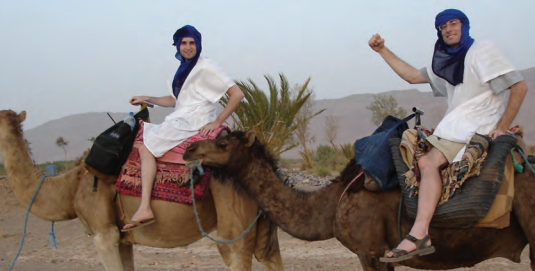In July, my friend Justin and I traveled to the Sahara desert in Southern Morocco. We camped out in the wilderness twice, the first time in Zagora, the second time in Merzouga. Both times, we traveled by camel to reach our campsites. Our camels in Zagora were some of the smallest, mangiest looking camels we had ever seen, yet they got us to our destination generally unscathed.
On our desert treks, we had little control of our camels because our nomad guide Muhammad pulled us the entire way. Camels provide an interesting travel experience, but not the most comfortable journey. While riding, our legs straddled our camels’ wide saddles, which were poorly cushioned by coarse blankets. Our legs dangled to the sides and constantly rubbed up against the blankets because the saddle had no stirrups. When we finally reached our campsite, the skin on our calves was chafed from all the rubbing and scratching. A bigger discomfort when camel riding is that the rider bounces every time the animal takes a step. As we rode back to town on our second day in the desert, our butts were so sore we actually got off the camels and walked most of the way.
In Merzouga, our camels were in slightly better shape than in Zagora, probably to traverse its overwhelming dunes. Some of the dunes were so high that you could rent skies or a snowboard to slide down. As we trekked into Merzouga’s tumbling ocean of sand, we felt we had finally reached the promised land. It was the desert we had fantasized about from watching films like “Lawrence of Arabia” and “The English Patient”; blazing hot, sandy, infi nite. Usually, our travel strategy in Merzouga was to navigate around the sand valleys, staying on top of the dune bluffs, but sometimes, we were forced to ride down into the sand pits. Every time we descended, our stomachs churned. Imagine a sharp drop on a roller coaster lasting about two seconds where you bounce up and down on a camel hump rather than rolling on wheels.

